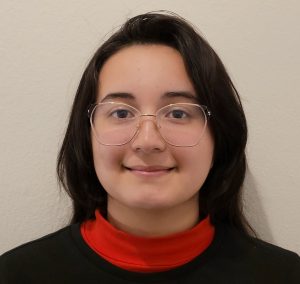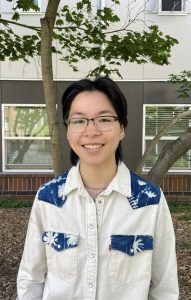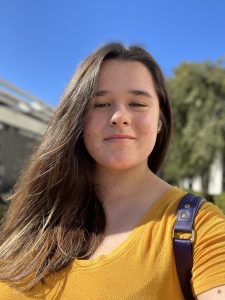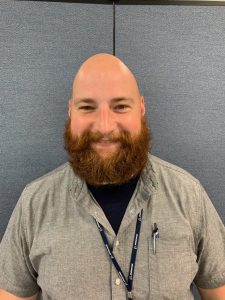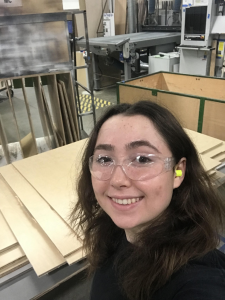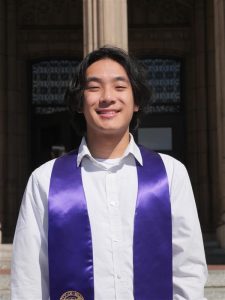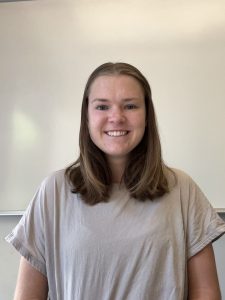The Washington Applied Sustainability Internship (WASI) program is a summer internship program designed to link dedicated engineering, chemistry, sustainability and environmental sciences students with business and industry in Washington. Interns research identified pollution prevention opportunities at a Host Business to analyze, recommend, and/or implement process changes to find and use safer chemical alternatives, reduce hazardous and solid wastes, conserve energy and water, reduce water contaminants and emissions, increase efficiency and cost savings, and improve employee health and safety. These pollution prevention internship projects will benefit Washington’s waterways and other natural resources.
2024 Projects and Success Stories
Bella Aguirre – Valence Surface Technologies
Industrial and Systems Engineering | University of Washington, Seattle
WASI Project: Waste Water Reduction
Industry: Aviation/Aerospace Component Manufacturing (NAICS: 3328)
The WASI internship project analyzed data and examined processes to optimize the water flow rate and chemical additions into the tanks including:
Identifying areas for water conservation through the analysis of the daily wastewater flow and total dissolved solids (TDS) levels for individual rinse tanks.
Analysis of both an automatic and a manual method to reduce water usage.
Water usage is measurably decreasing using this new process, with an estimated reduction of approximately 1540 gallons of water per day and a potential savings of about $1550 per month.
Valence Surface Technologies is the world’s leading aerospace product finishing company. They provide surface finishing processes including metal etching, chemical treatment, and painting of titanium, stainless steel, composite, aluminum, and plastic parts to the commercial and business aerospace, military and defense, space and satellite industries, and medical sciences. With over 200 employees, their two Seattle locations process small to medium-sized precision parts for the aerospace industry.
Valence Seattle has two wastewater pretreatment systems, which include a pH Neutralization System and a Batch Treatment System. Their wastewater discharge volume is approaching their maximum discharge limit. Valence wants to reduce their water usage and hazardous wastewater generation to ensure they stay below their permit limits and avoid costly non-compliance.
Casera Pinto – Taylor Farms
B.S. Environmental Engineering | University of Washington, Seattle
WASI Project: Water Usage and Waste Output Reduction
Industry:Food Manufacturing and Processing
This project analyzed the plant operations to reduce waste output and water usage at Taylor Farms Northwest. The WASI intern identified inefficiencies by engaging with various departments assessing current production workflows, tracing waste streams, observing overnight sanitation practices, and proposing targeted improvement projects in multiple areas.
Taylor Farms is a premier processor of salads and healthy fresh foods supplying many supermarket chains and food service restaurants in the United States. It’s headquartered in Salinas, CA, operates twenty-six processing plants nationwide, and employs over 20,000 workers.
Taylor Farms Northwest, located in Kent, WA, has over 500 employees and is focused on the deli food production sector of Taylor Farms. The packaged foods are stored in a refrigerated warehouse until shipped to the retail outlets.
Toray Industries, Inc. is committed to zero carbon emissions by 2050 and pursues measures to reduce its environmental impact and minimize hazardous waste.
Taylor Farms Northwest’s “Healthy Environment, Healthy Community, Healthy Business” motto guides its commitment to environmental sustainability. They look for opportunities to invest in continuous improvement and sustainability initiatives, focusing on reducing water usage, waste output, and resource consumption.
Reiden Emery – Toray Industries, Inc.
Biochemistry | California Polytechnic State University
WASI Project:Hazardous waste reduction and cost savings
Industry:Carbon and Graphite Manufacturing (NAICS: 335991)
Project 1: MEK tank connection
Toray ships Methyl ethyl ketone (MEK) offsite for treatment and disposal since the MEK dip tanks are not connected to the distillation unit. This incurs additional costs to the organization.
The WASI intern identified a pollution prevention project to recycle their waste MEK, reduce the amount of MEK shipped out for disposal, and nearly eliminate the amount of virgin MEK purchased. This is achieved by plumbing the MEK from the dip tanks to the distillation unit.
Using 3D modeling software, the WASI intern created a piping layout and consulted with maintenance and manufacturing engineers at Toray to ensure project feasibility. With their agreement, the intern compiled a list of necessary parts by referring to the existing n-methylpyrrolidone (NMP) dip tank connections and drawings, researching prices, and ensuring the correct parts were ordered. Toray Composite Materials America, Inc. Page 2 January 2025
Project 2: Solvent usability testing
The WASI intern established an easy test to determine the usability of the solvent in the dip tanks and to establish a solvent replacement schedule based on need.
Both the MEK and NMP dip tanks were flushed and replaced every two weeks for ease of operation.
The testing and analysis focused on the NMP tanks which became dirty more quickly.
The test measured the specific gravity of the solvent at various resin saturations, using the most difficult resin to dissolve. Measurements were taken at the operating temperature of the tanks to ensure easy replication for technicians. The WASI intern found that measuring specific gravity could be a viable option for measuring the usability of wash tanks, but further testing is required.
Project 3: Compacting hazardous waste
The WASI intern compiled data to determine if a compactor would reduce the cost of hazardous waste disposal. They looked at:
Current waste accumulation.
Shipping and disposal costs, and projections.
The cost-benefit analyses conclude that purchasing a compactor is the best course of action for reducing costs.
Toray Industries, Inc. is a multinational company based in Japan that produces industrial fibers, textiles, performance chemicals, and carbon fiber composite materials using organic synthetic chemistry and polymer chemistry. The company also develops products for environmental engineering and life science advancements. Toray Composite Materials America, Inc. (Toray), a subsidiary, manufactures carbon fiber and thermoset epoxy prepreg for use in aerospace, industrial, automotive, and defense industries.
Toray Industries, Inc. is committed to zero carbon emissions by 2050 and pursues measures to reduce its environmental impact and minimize hazardous waste.
Toray aims to reduce waste and lower operational costs with operational performance targets to reduce the amount of hazardous waste produced by 10% by the end of 2024. These goals include:
Recycling hazardous waste instead of shipping it off-site for treatment.
Optimizing solvent usage to reduce costs.
Implementing a process to reduce hazardous waste volume and shipping expenses.
Past Projects and Success Stories
Seth Kleckner – The Boeing Company
Environmental Science | University of Washington, Tacoma
WASI Project: Environmental Heat Map and Sludge Drying
Industry: Aerospace Manufacturing (NAICS 3364)
Seth created an environmental heat map to help Boeing prioritize projects based on the environmental impact. To reduce the volume of dangerous waste shipped off-site, Seth also researched different wastewater sludge drying techniques. He recommended a sludge dryer that could reduce hazardous waste by 242,000 pounds. Seth is an Environmental Studies major at the University of Washington in Tacoma.
The Boeing Company is a leading aerospace company servicing over 150 countries. Boeing is a top U.S. exporter and has been a leader in advancing economic opportunities and creating sustainable practices. They continue to innovate for the future, focusing on sustainability and community impact, by fostering their core values of safety, quality, and integrity.
Boeing Commercial Airplanes has been a leading manufacturer of commercial airplanes for decades. Boeing represents almost half of the world’s fleet with more than 10,000 commercial jetliners in service today. Currently, Boeing manufactures the 737, 767, 777, and 787 families of airplanes.
Boeing is committed to reducing their total waste footprint. They created the Global Enterprise Sustainability (GES) organization, which guide’s Boeing’s efforts to reduce waste and conserve environmental resources.
The Boeing Company has operational performance targets to meet by 2025, using 2017 as a baseline. These goals include reducing:
- Greenhouse gas emissions by 25 percent
- Water consumption by 20 percent
- Solid waste to landfill by 20 percent
- Energy consumption by 10 percent
- Hazardous waste by 5 percent
Ashley Cohen – Canyon Creek Cabinet Company
Environmental Studies | Carleton College
WASI Project: Wood Waste Reduction
Industry: Cabinet Manufacturer (NAICS 3371)
Ashley analyzed Canyon Creek’s wood waste to optimize wood scrap reuse. Recovering the readily usable scrap can save Canyon Creek over $537,000 annually. Ashley is studying Environmental Studies at Carleton College in Minnesota.
Canyon Creek Cabinet Company manufactures premium semi-custom cabinetry in Monroe, Washington, and markets its products to designers, builders, and a select network of independent dealers throughout the United States. Canyon Creek Cabinet Company has been a recognized leader in the kitchen and bath industry since 1981 and has won many industry awards for its cabinetry as well as for its commitment and efforts towards safer environmental practices.
The company has focused on sustainable manufacturing for more than 30 years and constantly looks for better materials and ways to cut energy use and create less waste. Current manufacturing processes prioritize efficiency over the conservation of valuable materials. This prioritization cost the company a previously unquantified sum of money that could instead be invested into more environmentally and financially beneficial business practices.
Canyon Creek’s emphasis on sustainability led them to look at the large quantity of wood scraps they were generating. Wood remnants that are larger than 9 x 5.5 inches are considered “usable scrap” and are recyclable. If a wood remnant is smaller than 9 x 5.5 inches, it is considered “scrap” and is not recyclable. The “scrap” is ground up and turned into wood chips or sawdust for easier transport out of the facility. Previously, Canyon Creek sold this waste as biofuel to a papermill that is now closed, so they are trying to minimize the amount of waste and find alternate disposal options.
Jimmy Huynh – SEKISUI Aerospace
Mechanical Engineering | University of Washington
WASI Project: Prepreg Waste Reduction
Industry: Aerospace Manufacturing (NAICS 3364)
Jimmy modified SEKISUI’s part kit and layup process, minimizing the amount of prepreg scrap created during product manufacturing. These changes can help reduce 1,200 pounds of hazardous materials and waste annually – for just one part. Jimmy graduated from the University of Washington in Seattle with a degree in Mechanical Engineering.
SEKISUI Aerospace specializes in the design and manufacture of composite products for the aerospace industry. SEKISUI offers innovative and cost-effective solutions for aerospace structures, systems, and interiors, catering to a wide range of customers.
SEKISUI Aerospace, a part of the SEKISUI Chemical Group, has over 700 employees spread across three sites in Renton and Sumner, Washington, and Orange City, Iowa.
SEKISUI actively prioritizes social and environmental value by decreasing their material use and process costs, thus lowering its environmental impact. These goals align with their parent company, SEKISUI Chemical, which has been selected as a 2023 Global 100 Sustainable Corporations in the World for the sixth consecutive year.
Payton Curley – Wilcox Farms
Environmental Science and Resource Management | University of Washington
WASI Project:Solid Waste Reduction and Recycling
Industry: Food and Beverage – Chicken Egg Production (NAICS 112310)
Payton helped Wilcox Farms divert over 340 tons of liquid egg waste and over 12,000 pounds of nitrogen from their wastewater lagoons to on-site manure compost. She also helped the farm recycle nearly 500,000 pounds of clean cardboard. Payton is studying Environmental Science and Resource Management at the University of Washington in Seattle.
Wilcox Farms is a family-owned and -operated farm based in Roy, Washington, that manufactures egg products. Wilcox Farms is dedicated to providing the highest quality eggs and raising happy, healthy hens. Through this mission and commitment to sustainable agriculture, they’ve developed a trustworthy and socially responsible brand image. Wilcox Farms follows the Certified Humane standards and offers free range, pasture raised, and certified organic eggs and egg products.
Wilcox Farms’ dedication to the livelihoods of their hens extends to preservation of the environment. They follow water reclamation and conservation guidelines and are certified salmon safe. Wilcox Farms are participants in Stewardship Partners, protecting wildlife that reside in the Nisqually River that runs directly through their property. Their core values include transparency, integrity, and humane practices. They value their chickens, employees, and the ecosystem where they operate.
As part of their commitment to sustainable agriculture, Wilcox Farms saw an opportunity to reduce levels of total nitrogen discharged into groundwater. Wilcox Farms believed reducing the amount of liquid egg waste discharged would significantly contribute to this reduction. Wilcox Farms also wanted to pursue alternate disposal options for the fiber and corrugated cardboard waste stream. In addressing these two waste streams, Wilcox also anticipated an increase in resource efficiency, maximizing product output while minimizing labor and reducing costs.
